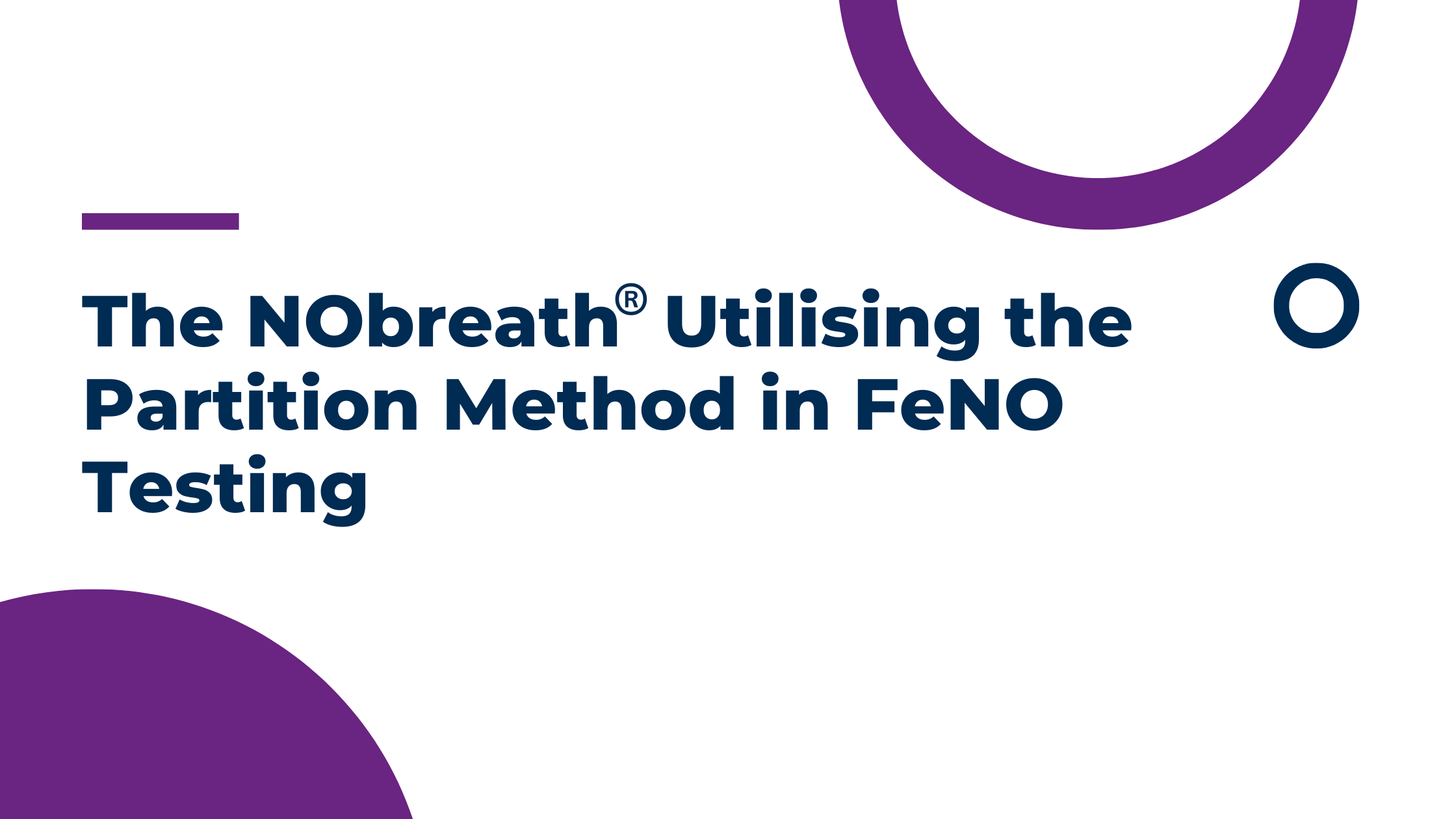
Methods of measuring FeNO
Fractional exhaled nitric oxide (FeNO) measurement plays a crucial role in the diagnosis and management of airway inflammation. FeNO testing is recommended by the National Institute for Health and Care Excellence (NICE) to help diagnose asthma1, with the NObreath® device one of three devices recommended by NICE1.
In 2005 the American Thoracic Society (ATS) and the European Respiratory Society (ERS) published recommendations for standardised procedures of FeNO testing highlighting that whilst evidence shows ambient levels of nitric oxide (NO) do not affect the result; it is preferable to avoid doubt by removing it from the breath sample2. This can be done by either ‘partitioning’ the sample; effectively ignoring the potential initial spike caused by ambient NO, or another method is inhaling through an NO scrubber before exhalation.
The NObreath® utilises the partition method. This article explores the partitioning method, how it works, and why Bedfont® Scientific Limited selected this method for the NObreath® device.
What is the partition method?
The partition method essentially ‘parts’ the breath sample, and omits the first few seconds to ensure any potential high ambient levels of NO present in the breath are not measured during sampling.
When performing a breath test with the NObreath®, the user will be prompted to take a deep breath and then instructed to blow gently into the mouthpiece with an onscreen flow meter to guide the patient on their exhalation rate. The NObreath® offers two test modes: A 12-second test mode and a 10-second test mode for those up to 10 years old who cannot complete the 12-second test mode.
As the breath sample enters the NObreath® device, the first few seconds are partitioned and vented through the device bypassing the sensor chamber. After the partition period has elapsed, the pump will draw the remaining viable sample into the sensor chamber, where the breath sample will be analysed. When the patient completes a breath test using the NObreath® a green tick will appear on the screen to indicate a successful test, and the patient’s results will be shown onscreen in parts per billion (ppb) instantly.
The NObreath® applying the partitioning method
The partition method is a user-friendly method designed to measure airway inflammation, providing instant results, and eliminating wait times for both patients and healthcare professionals. The patient does not have to inhale through a device that has been used on multiple prior patients, as even highly effective bacterial viral filters may not be 100% effective and the patient does not have to inhale through an NO scrubber*. Avoiding inhalation means these risks do not arise and this is another reason why Bedfont® chose this technique for NObreath®. The NObreath® also utilises an NO scrubber for accuracy but this does not form any part of the breath pathway.
To learn more about the NObreath® utilising partitioning method, please visit https://www.nobreathfeno.com/measuring-feno-with-the-nobreath/
FeNO testing
The use of FeNO testing, combined with a comprehensive clinical history and additional examinations, enhances the efficiency of asthma diagnosis and improves patient care. This allows for effective monitoring of patients’ responses to asthma interventions. Bedfont® are world leaders in breath analysis, with over 47 years of experience. Bedfont® has been manufacturing the NObreath® portable FeNO device for over 15 years. Used by healthcare professionals to measure airway inflammation to aid in the diagnosis and management of asthma, taking a minimal amount of valuable consultation time with the ability to monitor airway inflammation in both adult and child patients. With annual servicing and minimal consumables, the NObreath® can be used as a functional device for years**.
Visit https://www.nobreathfeno.com to learn how to support your patients with FeNO monitoring using the NObreath® from Bedfont® Scientific Limited.
*NO scrubbing filters typically utilise potassium permanganate (a potentially hazardous substance) which has been referenced in certain conditions, if inhaled, to cause irritation to the nose, throat and lungs causing coughing and/or shortness of breath3,4,5,6.
**The NObreath® has been validated for up to 29,000 tests when used as instructed and properly maintained and serviced. The number of tests can be periodically checked within the settings of the device; when 29,000 tests are reached a service is recommended. Contact your local service centre.
References:
- Measuring fractional exhaled nitric oxide concentration in asthma: NIOX MINO, NIOX VERO and NObreath [Internet]. National Institute for Health and Care Excellence. 2014. [Cited Monday 12th August 2024]. Available from: https://www.nice.org.uk/guidance/dg12/chapter/1-Recommendations
- American Thoracic Society Documents. ATS/ERS recommendations for standardised procedures for the online and offline measurement of exhaled lower respiratory nitric oxide and nasal nitric oxide, 2005. Am J Respir Crit Care Med. 2005;171(8):912-30. DOI: 10.1164/rccm.200406-710ST.
- Hazardous substance fact sheet [Internet]. New Jersey Department of Health and Senior Services. 2002. [Cited Monday 12th August 2024]. Available from: https://nj.gov/health/eoh/rtkweb/documents/fs/1578.pdf
- Safety data sheet potassium permanganate [Internet]. AquaPhoenix Scientific. 2015. [Cited Monday 12th August 2024]. Available from: https://beta-static.fishersci.com/content/dam/fishersci/en_US/documents/programs/education/regulatory-documents/sds/chemicals/chemicals-p/S25497.pdf
- . Potassium permanganate permanganic acid potassium salt [Internet]. Safety International Chemical Cards. 2016. [Cited Monday 12th August 2024]. Available from: https://www.ilo.org/dyn/icsc/showcard.display?p_lang=en&p_card_id=0672&p_version=2
- Potassium permanganate safety data sheet [Internet]. LabChem. 2014. [Cited Monday 12th August 2024]. Available from: https://palsusa.com/wp-content/uploads/sites/6/2024/08/POTASSIUM-PERMANGANATE.pdf
